| |
Our Authors, Translators and Editors
Here is the inspiring list of great writers who contributed to the works on Tolkien’s Bookshelf.
|
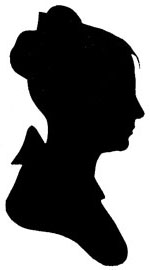
|
Margaret Armour (1890 - 1943)
Margaret Armour was born in Scotland on 10 September 1860. After receiving her education in Edinburgh, Munich and Paris, she married William Brown MacDougall (1868-1936) in Glasgow on 11 May 1895.
This remarkable woman was a poet, novelist and translator, skilled in German. The first book she wrote was 'The Home and Early Haunts of Robert Louis Stevenson' (1895), which she followed with three books of poetry. A novel, 'Agnes of Edinburgh', was published in 1910, after which she translated from German the poetry of Heinrich Heine.
Douglas A. Anderson writes, "Her translation from the Middle High German of 'Das Nibelungenlied' ('The Song of the Nibelungs') into what she called “plain prose” first appeared as 'The Fall of the Nibelungs' in 1897. It was later included in the Everyman’s Library, with subsequent editions retitled as 'The Nibelungenlied'. Similarly, her translation of 'Gudrun', which was published in 1928, also appeared in the Everyman’s Library. Along a similar vein of interest, in 1910 she translated Richard Wagner’s 'The Ring of the Nibelung'."
Margaret’s husband, an etcher, engraver and illustrator, was frequently involved with her books, usually signing his work as W.B. MacDougall. His work is mostly symbolic, grave, calm and beautiful. It is reminiscent of the work of Aubrey Beardsley, the famed art nouveay artist. MacDougall provided the stunning illustrations and decorations for 'The Song of the Nibelungs'. Around 1900, Armour and MacDougall settled in Essex, where MacDougall died on 20 April 1938. Armour returned to Edinburgh, where she died on 13 October 1943 at the age of 83. They had no children.
We have been unable to find any images of Margaret. We are keen to display her portrait, so if you know of any photos or paintings or her that we may use, please contact us!
|
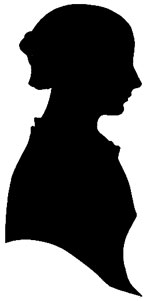
|
Olive Bray (Dates unknown)
The Journal of English and Germanic Philology, Vol. 28, No. 4, Oct., 1929 reviewed Olive Bray's translation of The Poetic Edda, stating:
'Miss Bray's work is eminently satisfactory: she possesses a scholar's knowledge of the subject (though she was by no means a specialist in the field); and she had poetic ability of a high order. She nearly always succeeded in reproducing the poetry and the spirit of the old lays and she adhered to the metrical form; to do these things she did not hesitate, to depart from rules of alliteration or sometimes to disregard alliteration entirely. '
Bray's superb translation of The Poetic Edda would have come to the attention of Tolkien, who admired this great Norse saga and indeed chose from it the names of his dwarves in 'The Hobbit'.
It is difficult to find any details about Miss Bray's life and work. If any of our readers can shed more light on the life of this excellent and erudite translator, please let us know! |

|
LUCY CRANE (1842 - 1882)
Englishwoman Lucy Crane, sister of artist Walter Crane, was a translator, an artist and lecturer on art. From an early age she showed considerable taste and skill in drawing and colouring. Circumstances, however, turned her attention to general educational work. She became an accomplished musician, and was not only distinguished for her delicacy of touch as an executant, but also for the classical refinement of her taste and her knowledge of the earlier Italian and English. She devoted her leisure to literature, writing in both verse and prose.
She contributed to the Argosy, and wrote the original verses (‘How Jessie was Lost,’ ‘The Adventures of Puffy,’ ‘Annie and Jack in London,’ and others) and rhymed versions of well-known nursery legends for her brother Walter's coloured toy-books.
The selection and arrangement of the accompaniments to the nursery songs in the ‘Baby's Opera’ and ‘Baby's Bouquet’ are also due to her; and a new translation by her of the Hausmärchen (Fairy Tales) of the Brothers Grimm was illustrated by her brother, Walter Crane. This is the volume that would no doubt have fallen into the hands of JRR Tolkien, as a young lad; the volume which he acknowledged as having inspired is work.
In the last few years of her life Lucy Crane delivered lectures in London and the north on Art and the Formation of Taste, which after her death were illustrated and published by Thomas and Walter Crane (1882), together with a short and appreciative notice of the author. She died on 31 March 1882.
|
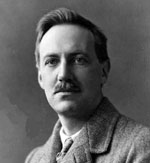
|
Lord Dunsany (1878-1957)
Irishman Edward John Moreton Drax Plunkett, 18th Baron of Dunsany, was a prolific fantasy short story writer whose books appeared around the turn of the 20th Century. Tolkien mentions Dunsany’s works many times in his collected letters.
Dunsany had more than eighty books published. His body of work includes hundreds of published short stories, in addition to popular plays, novels and essays.
Tolkien is known to have read and enjoyed more than one of his books, including The Book of Wonder.
From Wikipedia: 'Born to the second-oldest title (created 1439) in the Irish peerage, Dunsany lived much of his life at perhaps Ireland's longest-inhabited home, Dunsany Castle near Tara, worked with W.B. Yeats and Lady Gregory, received an honorary doctorate from Trinity College, was chess and pistol-shooting champion of Ireland, and travelled and hunted extensively. He died in Dublin after an attack of appendicitis.'
|
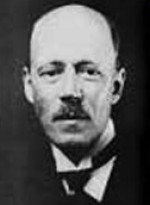
|
Eric Rücker Eddison (1882 - 1945)
The Dragon Ouroboros was first published under the title The Worm Ouroboros (the word for 'dragon' in Germanic mythology is worm - Old English: wyrm, Old High German: wurm - meaning 'snake' or 'serpent'). J.R.R. Tolkien read Eddison's story, and praised it in print, writing in a letter that he enjoyed Eddison’s books ‘for their sheer literary merit’. Eddison, he stated, was ‘the greatest and most convincing writer of “invented worlds”’ he had ever read.
Tolkien’s close friend and confidante C.S. Lewis was also an admirer, opining that ‘no writer can be said to remind us of Eddison’.
Eric Rücker Eddison was an English civil servant and author who was born in Leeds. As a boy, Eddison was tutored privately. Later he was educated at Eton and Trinity College, Oxford. In 1906 he joined the Board of Trade, where he performed so well that he was eventually appointed a Companion of the Order of St. Michael and St. George in 1924 and a Companion of the Order of the Bath in 1929 for public service. In 1938 he retired to become a full-time writer. He was married, with one child, a daughter. Their son-in-law, a Royal Air Force pilot, died in the Second World War.
Wikipedia says: 'Eddison is best known for his early romance novel The Worm Ouroboros (1922) and for three volumes set in the imaginary world Zimiamvia, known as the Zimiamvian Trilogy: Mistress of Mistresses (1935), A Fish Dinner in Memison (1941), and The Mezentian Gate (1958).
'These early works of high fantasy drew strong praise from J. R. R. Tolkien, C. S. Lewis, and later, Ursula K. Le Guin. Tolkien generally approved Eddison's literary style, but found the underlying philosophy rebarbative; while Eddison in turn thought Tolkien's views "soft". Other admirers of Eddison's work included James Stephens, who wrote the introduction to the 1922 edition; Robert Silverberg, who described The Worm Ouroboros as "the greatest high fantasy of them all"; and Clive Barker.
'Eddison's books are written in a meticulously recreated Jacobean prose style, seeded throughout with fragments, often acknowledged but often directly copied from his favorite authors and genres: Homer and Sappho, Shakespeare and Webster, Norse Sagas and French medieval lyric poems.'
|
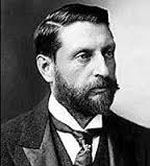
|
H. Rider Haggard (1856 - 1925)
Sir Henry Rider Haggard, KBE (22 June 1856 – 14 May 1925) was an English author. He wrote adventure novels in exotic settings, chiefly colonial Africa, where he lived, worked and travelled for several years. His stories were the first in the 'Lost World' literary genre, which influenced popular American pulp writers such as Edgar Rice Burroughs, Robert E. Howard, Philip José Farmer, and Abraham Merritt.
Tolkien greatly enjoyed Haggard's novels, in particular 'She' (1887)and 'Eric Brighteyes' (1891). It can be imagined that he would have been interested in the other three titles in the immensely popular 'She' series when they appeared - 'Ayesha: The Return of She' (1905),' She and Allan' (1921), and 'Wisdom's Daughter' (1923). Fantasy author H.P. Lovecraft, too, praised Haggard.
To 21st century readers parts of Haggard's work may seem 'politically incorrect'. He was a man of his time, as we are men and women of ours. His books are not devoid of racism, sexism and ruthless exploitation of wild animals; it is best, however, to with-hold judgement and not allow it to spoil the pleasure of reading literary classics.
Several of Haggard's books contain references to volcanoes. Reading them, one is reminded of Tolkien's descriptions of Mount Doom. In 'She', Haggard depicts marshlands reminiscent of the Dead Marshes in The Lord of the Rings. Haggard's protagonists, like Tolkien's, make long journeys, endure painful ordeals, travel underground and are often swept into wars. They encounter beings who are either impossibly long-lived or immortal. Landscape, rock formations and geography play a vital role in Haggard's adventures, as they do in Tolkien's work.
|

|
Andrew Lang (1844 – 1912)
Lang
was a Scots poet, novelist, literary critic, and contributor to the field of anthropology. He is best known as a collector of folk and fairy tales.
Andrew Lang's Fairy Books captured the imagination of a generation of children and were sold worldwide in the 1880s and 1890s. Tolkien praised the series, particularly mentioning The Red Fairy Book.
From Wikipedia: 'Born in Selkirk, Scotland, Lang was the eldest of the eight children. He was educated at the Edinburgh Academy, St Andrews University and at Balliol College, Oxford, where he took a first class in the final classical schools in 1868, becoming a fellow and then honorary fellow of Merton College. As a journalist, poet, critic and historian, he quickly made a reputation as one of the most able and versatile writers of the day.
'In 1875 Lang married Leonora Blanche Alleyne, who was (or should have been) variously credited as author, collaborator, and/or translator of the Color/Rainbow Fairy Books Lang edited.
'Lang was one of the founders of 'psychical research', and he served as President of the Society for Psychical Research in 1911.
His writings on Scottish history are characterised by a scholarly care for detail, a piquant literary style, and a gift for disentangling complicated questions.
'Lang is mainly remembered for his books on folklore, mythology, and religion. He now lies buried in the cathedral precincts at St Andrews, Scotland.'
|
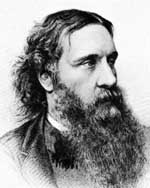
|
George MacDonald (1824-1905)
From Wikipedia: '
MacDonald was a prolific novelist. He is now known particularly for his poignant fairy tales and fantasy works, and their influence on later authors, such as W. H. Auden, C. S. Lewis, E. Nesbit and Madeleine L'Engle.
C. S. Lewis wrote that he regarded MacDonald as his "master": "Picking up a copy of Phantastes one day at a train-station bookstall, I began to read. A few hours later," said Lewis, "I knew that I had crossed a great frontier."
G. K. Chesterton cited The Princess and the Goblin as a book that had "made a difference to my whole existence."
Even Mark Twain, who initially disliked MacDonald, became friends with him, and there is some evidence that Twain was influenced by MacDonald.
'MacDonald grew up in the Congregational Church, with an atmosphere of Calvinism.He took his degree at the University of Aberdeen, and then went to London, studying at Highbury College for the Congregational ministry.
George MacDonald best-known works are Phantastes, The Princess and the Goblin, At the Back of the North Wind, and Lilith, all fantasy novels, and fairy tales such as "The Light Princess", "The Golden Key", and "The Wise Woman". "I write, not for children," he wrote, "but for the child-like, whether they be of five, or fifty, or seventy-five." MacDonald also published some volumes of sermons, the pulpit not having proved an unreservedly successful venue.
'MacDonald also served as a mentor to Lewis Carroll (the pen-name of Rev. Charles Lutwidge Dodgson); it was MacDonald's advice, and the enthusiastic reception of Alice by MacDonald's many sons and daughters, that convinced Carroll to submit Alice for publication.[6] Carroll, one of the finest Victorian photographers, also created photographic portraits of several of the MacDonald children.
'MacDonald was also friends with John Ruskin and served as a go-between in Ruskin's long courtship with Rose La Touche.
'MacDonald was acquainted with most of the literary luminaries of the day; a surviving group photograph shows him with Tennyson, Dickens, Wilkie Collins, Trollope, Ruskin, Lewes, and Thackeray. While in America he was a friend of Longfellow and Walt Whitman.
'MacDonald's use of fantasy as a literary medium for exploring the human condition greatly influenced a generation of such notable authors as C. S. Lewis (who featured him as a character in his The Great Divorce), J. R. R. Tolkien, and Madeleine L'Engle. MacDonald's non-fantasy novels, such as Alec Forbes, had their influence as well; they were among the first realistic Scottish novels.
|

|
William Morris (1834-1896)
From Wikipedia: Morris was an English textile designer, artist, writer, and socialist associated with the Pre-Raphaelite Brotherhood and English Arts and Crafts Movement. He founded a design firm in partnership with the artist Edward Burne-Jones, and the poet and artist Dante Gabriel Rossetti which profoundly influenced the decoration of churches and houses into the early 20th century. As an author, illustrator and medievalist, he helped to establish the modern fantasy genre, and was a direct influence on postwar authors such as J. R. R. Tolkien. He was also a major contributor to reviving traditional textile arts and methods of production, and one of the founders of the Society for the Protection of Ancient Buildings, now a statutory element in the preservation of historic buildings in the UK.
Morris wrote and published poetry, fiction, and translations of ancient and medieval texts throughout his life. He was an important figure in the emergence of socialism in Britain, founding the Socialist League in 1884, but breaking with that organization over goals and methods by the end of the decade. He devoted much of the rest of his life to the Kelmscott Press, which he founded in 1891. Kelmscott was devoted to the publishing of limited-edition, illuminated-style print books. The 1896 Kelmscott edition of the Works of Geoffrey Chaucer is considered a masterpiece of book design.
As a child Morris was delicate but studious. He learned to read early, and by the time he was four years old he was familiar with most of the Waverley novels by Sir Walter Scott. When he was six the family moved to Woodford Hall, where new opportunities for an out-of-door life brought the boy health and vigour. He rode about Epping Forest, sometimes in a toy suit of armour, where he became a close observer of animal nature and was able to recognize any bird upon the wing.
At the same time he continued to read whatever came in his way and was particularly attracted by the stories in the Arabian Nights and by the designs in Gerard's Herbal. He studied with his sisters' governess until he was nine, when he was sent to a school at Walthamstow.
In 1842, his sister Isabella was born. In his thirteenth year their father died, leaving the family well-to-do. Much of the family's wealth came from a copper and later arsenic mine, Devon Great Consols, which Morris sold off in the 1870s.
In 1852 Morris entered Exeter College, Oxford, where he met Edward Burne-Jones, also a first year undergraduate, who became his lifelong friend and collaborator. Through Burne-Jones Morris also joined a group of undergraduates from Birmingham at Pembroke College, known among themselves as the "Brotherhood" and to historians as the Birmingham Set. Together, they read theology, ecclesiastical history, and medieval poetry; studied art, and during the long vacations visited English churches and the Continental cathedrals. They became strongly influenced by the paintings of the Pre-Raphaelites, John Ruskin's essay "The Nature of Gothic" from the second volume of The Stones of Venice, Thomas Malory's Morte d'Arthur and the poetry of Alfred, Lord Tennyson. Morris began to adopt Ruskin's philosophy of rejecting the tawdry industrial manufacture of decorative arts and architecture in favour of a return to hand-craftsmanship, raising artisans to the status of artists, creating art that should be affordable and hand-made, with no hierarchy of artistic mediums.
Moreover, Morris began at this time to write poetry and many of his first pieces, afterwards destroyed, were held by sound judges to be equal to anything else he ever worked on. Both Morris and Burne-Jones had come to Oxford with the intention of taking holy orders, but as they felt their way, both decided their energies were best spent on social reform. Morris decided to become an architect.
While organising the publication of a magazine for the better propagation of the views of the new brotherhood, Morris met Dante Gabriel Rossetti, a contributor. The two became friends. Rossetti had seen Jane Burden at a theatre performance and recruited her to model as Guinevere for the Oxford Union murals. Morris was smitten with Jane from the start. They became engaged in 1858 and married at St Michael at the Northgate, Oxford, on 26 April 1859, settling temporarily at 41 Great Ormond Street, London. Morris's only surviving painting in oils is of Jane Burden as La Belle Iseult. William and Jane had two daughters, Jane Alice (Jenny), who developed epilepsy in her teens, and Mary (May), who became the editor of her father's works, a prominent socialist, and an accomplished designer and craftswoman.
Although of humble origins and unschooled in her youth, Jane Morris underwent a remarkable self-education after her marriage.
For several years after his marriage Morris was absorbed in two connected occupations: the building and decoration of a house for himself and Jane, and the foundation of a firm of decorators who were also artists, with the view of reinstating decoration, down to its smallest details, as one of the fine arts. Meanwhile he was slowly abandoning painting; none of his paintings are dated later than 1862.
In 1861, the decorative arts firm of Morris, Marshall, Faulkner & Co. (later described by Nicholas Pevsner as the 'beginning of a new era in Western art ') was founded with Morris, Rossetti, Burne-Jones, Ford Madox Brown and Philip Webb as partners, together with Charles Faulkner and Peter Paul Marshall, the former of whom was a member of the Oxford Brotherhood, and the latter a friend of Brown and Rossetti. The prospectus set forth that the firm would undertake carving, stained glass, metal-work, paper-hangings, chintzes (printed fabrics), and carpets. The decoration of churches was from the first an important part of the business. On its non-ecclesiastical side it gradually was extended to include, besides painted windows and mural decoration, furniture, metal and glass wares, cloth and paper wall-hangings, embroideries, jewellery, woven and knotted carpets, silk damasks, and tapestries. The first headquarters of the firm were at 8 Red Lion Square.
The work shown by the firm at the 1862 International Exhibition attracted much notice, and from 1866 began to make a profit.
A striking beauty, Jane Morris mixed freely with the Pre-Raphaelites and posed many times for Dante Gabriel Rossetti, with whom Jane had a long affair. The Morrises' initial happiness together did not survive the first ten years of their marriage, but divorce was unthinkable, and they remained together until Morris's death.
In 1869, Morris and Rossetti rented a country house, Kelmscott Manor at Kelmscott, Oxfordshire, as a summer retreat, but it soon became a retreat for Rossetti and Jane Morris to have their long-lasting and complicated liaison. The two spent summers there, with the Morris children, while Morris himself travelled to Iceland in 1871 and 1873. Kelmscott Manor remained an important retreat and symbol of simple country life for Morris in later years.
In his later years, Morris returned to the paramount interests of his life: art and literature. When his business was enlarged in 1881 by the establishment of a tapestry industry at Merton Abbey Mills, in Surrey (now absorbed into South West London), Morris found yet another means for expressing the medievalism that inspired all his work, whether on paper or at the loom. He then added another to his many activities; he assumed a direct interest in typography. In 1894 his beautifully typeset and decorated book The Glittering Plain was published.
William Morris was a prolific writer of poetry, fiction, essays, and translations of ancient and medieval texts. His first poems were published when he was 24 years old, and he was polishing his final novel, The Sundering Flood, at the time of his death. His daughter May's edition of Morris's Collected Works (1910–1915) runs to 24 volumes, and two more were published in 1936.
|
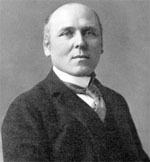
|
Howard Pyle (1853-1911)
Howard Pyle (March 5, 1853 – November 9, 1911) was an American illustrator and author, primarily of books for young people. A native of Wilmington, Delaware, he spent the last year of his life in Florence, Italy.
In 1894 he began teaching illustration at the Drexel Institute of Art, Science and Industry (now Drexel University). After 1900, he founded his own school of art and illustration, named the Howard Pyle School of Illustration Art. The scholar Henry C. Pitz later used the term Brandywine School for the illustration artists and Wyeth family artists of the Brandywine region, several of whom had studied with Pyle.[1] Some of his more notable students were N. C. Wyeth, Frank Schoonover, Elenore Abbott, Ethel Franklin Betts, Anna Whelan Betts, Harvey Dunn, Clyde O. DeLand, Philip R. Goodwin, Violet Oakley, Ellen Bernard Thompson Pyle, Olive Rush, Allen Tupper True, Elizabeth Shippen Green, and Jessie Willcox Smith.
His 1883 classic publication The Merry Adventures of Robin Hood remains in print, and his other books, frequently with medieval European settings, include a four-volume set on King Arthur. He is also well known for his illustrations of pirates, and is credited with creating what has become the modern stereotype of pirate dress. He published his first novel, Otto of the Silver Hand, in 1888. He also illustrated historical and adventure stories for periodicals such as Harper's Weekly and St. Nicholas Magazine. His novel Men of Iron was adapted as the movie The Black Shield of Falworth (1954).
Pyle travelled to Florence, Italy in 1910 to study mural painting. He died there in 1911 of a sudden kidney infection (Bright's Disease)
|
|